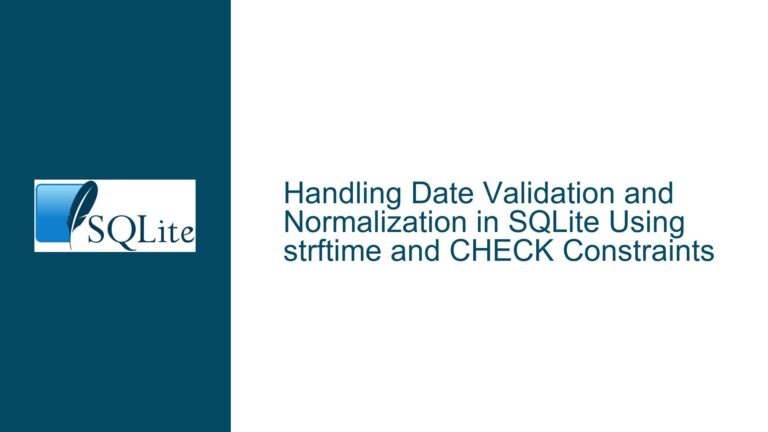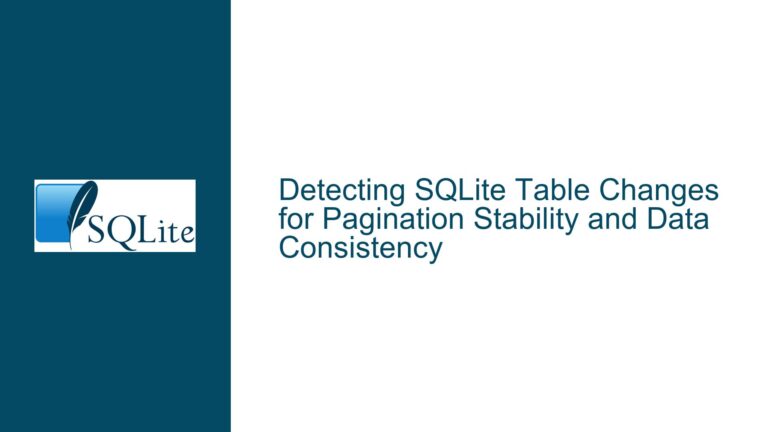Write Lock Acquisition in SQLite UPDATE Queries with Nested SELECT Subqueries
Atomic Execution of UPDATE-SELECT Operations and Transaction Boundaries
SQLite operations involving both read (SELECT) and write (UPDATE) components within a single statement are executed as atomic transactions. When an UPDATE statement includes a nested SELECT subquery—such as UPDATE Info SET Timestamp = 1234 WHERE rowid IN (SELECT rowid FROM Info WHERE Timestamp IS NULL LIMIT 10);—the entire operation is processed within a single transaction. This transaction is either explicitly declared by the user or implicitly created by SQLite when no explicit transaction exists.
The atomicity of the operation ensures that all components of the statement—the evaluation of the subquery, the identification of target rows, and the modification of data—are treated as an indivisible unit. During execution, SQLite adheres to the SERIALIZABLE isolation level, which guarantees that no intermediate states of the transaction are visible to other database connections. This isolation prevents "dirty reads" and ensures that concurrent operations observe the database either in its state before the transaction or after its successful completion, but never in a partially modified state.
A critical aspect of this atomic execution is the acquisition of write locks. SQLite employs a locking hierarchy that transitions through RESERVED, PENDING, and EXCLUSIVE states during write operations. For the example UPDATE statement, the RESERVED lock is acquired early in the transaction lifecycle, typically before any changes are written to the database file. However, the timing of lock acquisition is optimized to minimize contention: SQLite defers the actual writing of modified pages to the database file until the transaction commits, while still ensuring that the RESERVED lock is held for the duration of the transaction.
This design has two implications:
- The nested
SELECTsubquery executes within the same transaction as theUPDATE, meaning it operates on a consistent snapshot of the database as it existed when the transaction began. - Competing connections attempting to modify the same data will be blocked or forced to retry until the initial transaction completes, ensuring that overlapping updates cannot occur.
Misconceptions About Write Lock Timing and Concurrent Access Race Conditions
A common misconception arises from the assumption that the write lock (specifically the RESERVED or EXCLUSIVE lock) is acquired only after the nested SELECT subquery completes. This misunderstanding leads to concerns that concurrent connections could execute overlapping SELECT phases, identify the same target rows, and proceed to perform conflicting updates.
In reality, SQLite’s transactional model and locking protocol prevent this scenario. The RESERVED lock is acquired at the start of the write transaction, which for an implicit transaction begins with the first write operation. However, because the UPDATE and its nested SELECT are part of the same statement, the entire process is encapsulated within a single transaction. The RESERVED lock is held throughout, preventing other writers from modifying the database until the transaction concludes.
The isolation properties of SQLite further mitigate risks:
- No Cross-Transaction Visibility: Changes made within a transaction are visible only to the connection that initiated the transaction. Other connections see the database as it existed before the transaction began.
- Writer Serialization: Only one writer may hold the
RESERVEDorEXCLUSIVElock at any time. Competing writers must wait or abort their transactions. - Transaction Rollback on Contention: If a connection cannot acquire the necessary locks after a timeout, its transaction is rolled back, forcing the application to retry the operation with a fresh view of the database.
Consider the hypothetical race condition where two connections execute the same UPDATE-SELECT statement concurrently:
- Connection A begins an implicit transaction, evaluates the
SELECTsubquery, and identifies 10 rows withTimestamp IS NULL. - Connection B attempts to execute the same statement but is blocked by Connection A’s
RESERVEDlock. - Connection A completes its
UPDATE, commits the transaction, and releases the lock. - Connection B acquires the
RESERVEDlock, re-evaluates theSELECTsubquery (now seeing the updatedTimestampvalues from Connection A), and finds zero rows to update.
This sequence demonstrates that SQLite’s locking and isolation mechanisms inherently prevent conflicting updates, even when subqueries are involved.
Leveraging Transaction Isolation and Locking Protocols to Prevent Overlapping Updates
To ensure robust concurrency control in applications using SQLite, adhere to the following principles:
1. Use Explicit Transactions for Multi-Statement Operations
While SQLite automatically wraps single statements in implicit transactions, explicit transactions provide clarity and control. For example:
BEGIN IMMEDIATE; -- Acquires a RESERVED lock immediately
UPDATE Info SET Timestamp = 1234 WHERE rowid IN (SELECT rowid FROM Info WHERE Timestamp IS NULL LIMIT 10);
COMMIT;
The BEGIN IMMEDIATE directive explicitly acquires the RESERVED lock at the start of the transaction, reducing the window for contention.
2. Handle SQLITE_BUSY Errors with Retry Logic
When a connection cannot acquire a lock due to contention, SQLite returns SQLITE_BUSY. Applications should implement retry mechanisms with exponential backoff to handle this gracefully:
max_retries = 5
retry_delay = 0.1 # seconds
for attempt in range(max_retries):
try:
cursor.execute("BEGIN IMMEDIATE")
cursor.execute("UPDATE ...")
cursor.execute("COMMIT")
break
except sqlite3.OperationalError as e:
if "database is locked" in str(e) and attempt < max_retries - 1:
time.sleep(retry_delay * (2 ** attempt))
continue
else:
raise
3. Optimize for WAL Mode When Appropriate
Using Write-Ahead Logging (WAL) mode (PRAGMA journal_mode=WAL;) allows concurrent reads and writes, but writers still serialize. WAL mode can improve performance in read-heavy workloads but does not eliminate the need for transactional rigor.
4. Avoid Cross-Connection State Assumptions
Each database connection operates independently. Do not assume that one connection’s uncommitted changes are visible to others. Use post-update verification queries if necessary:
UPDATE Info SET Timestamp = 1234
WHERE rowid IN (SELECT rowid FROM Info WHERE Timestamp IS NULL LIMIT 10);
-- Verify that the update succeeded
SELECT COUNT(*) FROM Info WHERE Timestamp = 1234;
5. Utilize Row-Level Locking via Careful WHERE Clauses
Although SQLite uses page-level locking, narrowing WHERE clauses to target specific rows reduces the likelihood of lock contention. For example, using indexed columns in the WHERE clause minimizes the number of pages locked.
By internalizing these practices, developers can confidently build applications that leverage SQLite’s concurrency model without fear of undetected race conditions or overlapping updates. The engine’s design inherently prioritizes data integrity, and understanding its locking and isolation protocols is key to harnessing its full potential.






